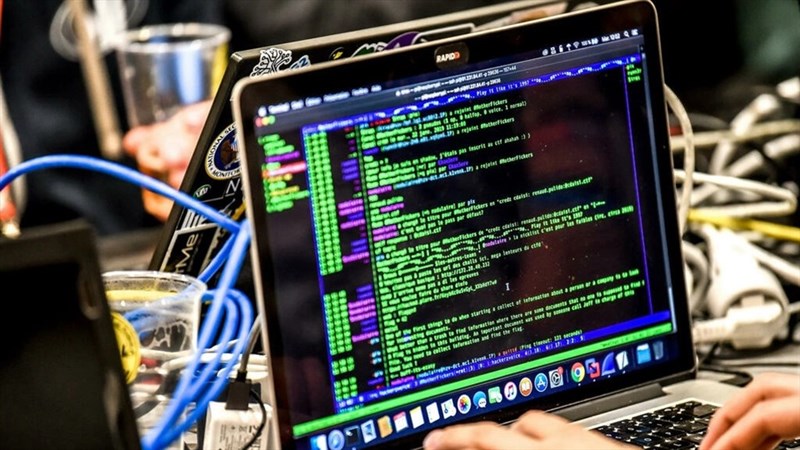Russia and the United States have long established programs to train dolphins and cetaceans for military purposes.
Recent satellite images show that Russia may be using dolphins to prevent enemy divers from ambushing the Black Sea port of Sevastopol, during a special military operation in Ukraine.
The Russian Navy appears to have installed two dolphin pens at the entrance to the port of Sevastopol. These cages were brought here around February, near the time of the special military operation in Ukraine began, submarine and underwater systems expert HI Sutton said on April 27 after analyzing satellite images.
Sutton said these dolphins were trained to prevent the scenario of Ukrainian commandos infiltrating the Sevastopol military port and damaging infrastructure and ships.

A bottlenose dolphin swims on the sea surface near Kennedy Space Center, USA, in 2009. Photo: Reuters.
In 2019, fishermen in the Finnmark area, off the northern coast of Norway, spotted a white whale (beluga whale) wearing a ring with a camera mount with the words “St. Petersburg Equipment” printed on it. plastic latch.
Experts at the time speculated that the whale was a “Russian spy”, because of the markings on the bracelet and rumors about Russia conducting a training program of white whales for military purposes.
Another theory is that the whale came from the US. The words “St. Petersburg Appliance” are written in English, so it is possible that the name of the city of St. Petersburg. Petersburg, Florida, USA, where there are water parks with white whales.
In 2017, Russian state media reported that the country was experimenting with the use of white whales, bottlenose dolphins and certain species of seals to guard entrances to naval bases, assist divers and even have can attack foreign objects infiltrating the protected target area.
Paul Nachtigall, head of the marine mammal research program at the University of Hawaii, US, said bottlenose dolphins detect mines more effectively than any machine. “They can also do it much faster than machines,” he said.
Dolphins can be especially effective near shore, where the sound of waves and boat engines cause a lot of acoustic noise, making technological systems less efficient, Nachtigall noted.
According to Nachtigall, dolphins have the ability to navigate underwater very well. They emit sound waves, then receive the reflected wave back to build a picture of their surroundings using the sound.

Dolphin cage near the entrance to Russia’s Sevastopol naval base on the Crimean peninsula in April. Photo: Maxar.
Experiments conducted by Nachtigall in the mid-1990s with a bottlenose dolphin named BJ showed this particularly sensitive ability. Nachtigall asked BJ to distinguish metal posts made of stainless steel, brass, and aluminum. Although he buried the objects under 60cm of mud, BJ still detected and distinguished them.
Researchers still don’t know how dolphins do this, Nachtigall said, but it’s a topic that has attracted the attention of military and civilian scientists for decades.
In the 1960s, at the height of the Cold War, Soviet officials are said to have trained white whales, dolphins, sea lions and seals to search for mines and other objects. .
Lev Mukhametov, a leading researcher in ecology and evolution at the Russian Academy of Sciences, says he has witnessed how bottlenose dolphins were used during the Soviet era to “guard” the entrance to Sevastopol Bay in Crimea. , where the Black Sea Fleet is stationed. If a diver enters the protected area, the dolphin will “signal” to a coastal station using sonar.
After the dissolution of the Soviet Union, the marine mammal training program was suspended. But in 2012, the program resumed in Ukraine, according to the Russian news agency RIA Novosti. In 2014, after Russia annexed Crimea to its territory, these trained dolphins came under the control of the Russian Defense Ministry.
The Russian Navy is then said to have launched a new program to train dolphins and seals for military purposes. According to Washington PostIn 2016, Russia began looking for “rookies”, buying 5 bottlenose dolphins for $ 24,000.
In 2017, TV channel Zvezda Russia’s Defense Ministry reported that the country’s “underwater task force” is receiving “new warriors”, including seals, bottlenose dolphins and white whales. They will guard the entrance to the naval base, find mines, assist divers and possibly engage in combat against “any outsider who encroaches on their territory”.
But the military use of cetaceans is not limited to Russia. The US Navy has also had a similar program since the 1960s. The ability to detect and target these animals in the deep sea or turbulent waters is something technology has not been able to catch up.

A bottlenose dolphin is being trained by the US Navy to search for mines in 2018. Photo: US Navy.
In 2019, the US Central Intelligence Agency (CIA) declassified a number of documents detailing various experiments, including a training program for warrior dolphins called “Project OXYGAS”.
Documents show that the CIA launched OXYGAS in the early 1960s using at least two captured wild dolphins, with the intention of training them to quietly infiltrate enemy bays and harbors. Attach an explosive device to the hull of an enemy ship and then return to a designated location.
By November 1964, the Office of Research and Development (ORD), the scientific research arm of the US Environmental Protection Agency, said the program was “moving ahead faster than anticipated” and the CIA had conducted a full-scale testing in January 1965.
The CIA was so impressed with OXYGAS that they envisioned many secret missions for dolphins, such as attacking ships, scouting harbors and shores using photographic equipment, gathering intelligence, or placing buoys. minus.
Despite the program’s progress, the CIA eventually encountered a difficult problem to solve: Wildlife is often unstable and unreliable. In 1967, the CIA changed the OXYGAS program, focusing on training dolphins for intelligence gathering purposes.
In the new role, the CIA’s dolphins will approach the hostile nation’s waters from a distance of at least 19 kilometers, out of territorial waters. They would then pick up intelligence objects left behind by American spies in shallow water or floating near shore.
However, CIA experts realized that it is very difficult to train dolphins to move more than 19 km through unfamiliar waters. By September 1967, the OXYGAS project began to lose momentum. In 1970, the CIA completely abandoned the dolphin training program to attack and spy, but the mission of protection and rescue was still maintained.
Today, the Kitsap naval base in Seattle, Washington state is where many American “dolphin warriors” are being trained and on duty.
Here, if a mine or any other threat is detected, the dolphins will immediately come to the trainer. This person will give them a buoy to mark the location of the mine, to help ships avoid while waiting for divers to deal with the danger.
The US Navy says the Kitsap base is home to about 25% of the US’ 9,962 nuclear warheads, so it needs to be protected in all directions, including under the sea. According to US Navy spokesman Chris Haley, dolphins and sea lions have been used to protect the waters around Kitsap since 2010.
Vu Hoang (According to Military, Time)
at Blogtuan.info – Source: vnexpress.net – Read the original article here



